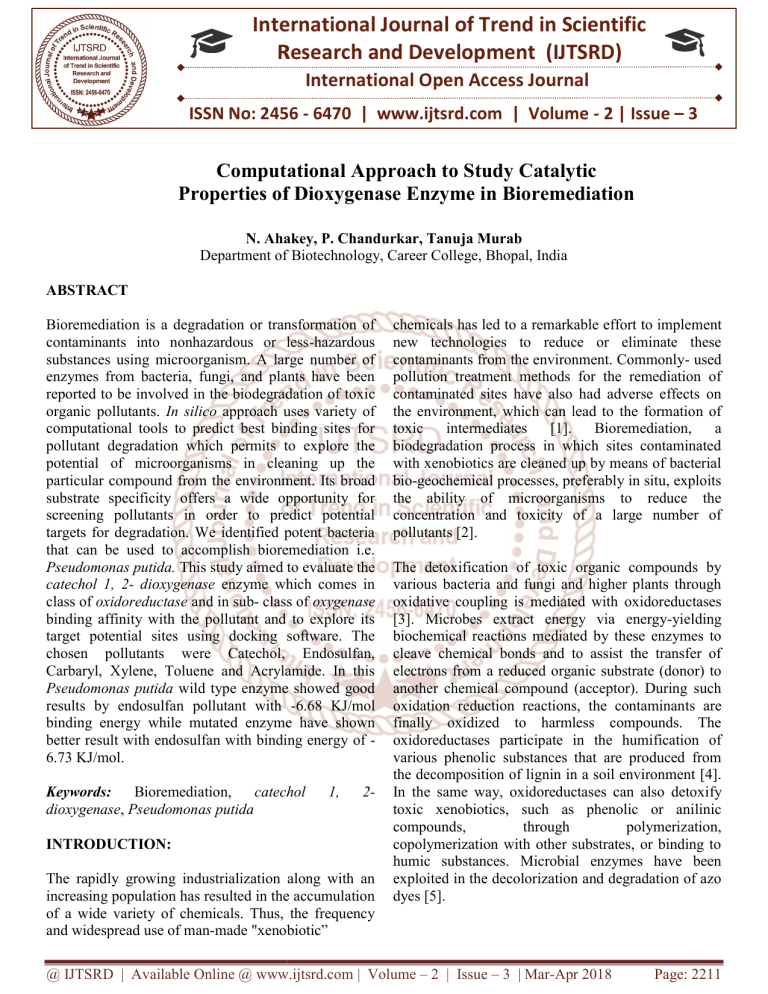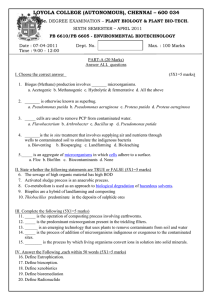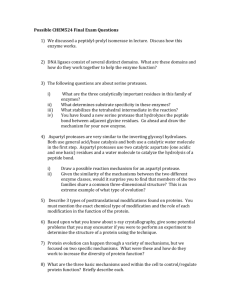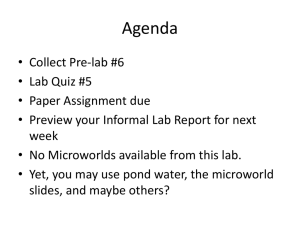
International Journal of Trend in Scientific
Research and Development (IJTSRD)
International Open Access Journal
ISSN No: 2456 - 6470 | www.ijtsrd.com | Volume - 2 | Issue – 3
Computational Approach tto
o Study Catalytic
Properties of Dioxygenase Enzyme iin
n Bioremediation
N. Ahakey, P. Chandurkar, Tanuja Murab
Department of Biotechnology, Career College, Bhopal, India
ABSTRACT
Bioremediation is a degradation or transformation of
contaminants into nonhazardous or less
less-hazardous
substances using microorganism. A large number of
enzymes from bacteria, fungi, and plants have been
reported to be involved in the biodegradation of toxi
toxic
organic pollutants. In silico approach uses variety of
computational tools to predict best binding sites for
pollutant degradation which permits to explore the
potential of microorganisms in cleaning up the
particular compound from the environment. Its bbroad
substrate specificity offers a wide opportunity for
screening pollutants in order to predict potential
targets for degradation. We identified potent bacteria
that can be used to accomplish bioremediation i.e.
Pseudomonas putida. This study aimed to eevaluate the
catechol 1, 2- dioxygenase enzyme which comes in
class of oxidoreductase and in sub- class of oxygenase
binding affinity with the pollutant and to explore its
target potential sites using docking software. The
chosen pollutants were Catechol, E
Endosulfan,
Carbaryl, Xylene, Toluene and Acrylamide. In this
Pseudomonas putida wild type enzyme showed good
results by endosulfan pollutant with -6.68 KJ/mol
binding energy while mutated enzyme have shown
better result with endosulfan with binding energy of 6.73 KJ/mol.
Keywords:
Bioremediation,
catechol
dioxygenase, Pseudomonas putida
1,
2-
INTRODUCTION:
The rapidly growing industrialization along with an
increasing population has resulted in the accumulation
of a wide variety of chemicals. Thus, the frequency
and widespread use of man-made
made "xenobiotic”
chemicals has led to a remarkable effort to implement
implem
new technologies to reduce or eliminate these
contaminants from the environment. CommonlyCommonly used
pollution treatment methods for the remediation of
contaminated sites have also had adverse effects on
the environment, which can lead to the formation of
toxic
oxic
intermediates
[1].
Bioremediation,
a
biodegradation process in which sites contaminated
with xenobiotics are cleaned up by means of bacterial
bio-geochemical
geochemical processes, preferably in situ, exploits
the ability of microorganisms to reduce the
concentration
tion and toxicity of a large number of
pollutants [2].
The detoxification of toxic organic compounds by
various bacteria and fungi and higher plants through
oxidative coupling is mediated with oxidoreductases
[3]. Microbes extract energy via energy-yielding
energy
biochemical reactions mediated by these enzymes to
cleave chemical bonds and to assist the transfer of
electrons from a reduced organic substrate (donor) to
another chemical compound (acceptor). During such
oxidation reduction reactions, the contaminants
contaminan are
finally oxidized to harmless compounds. The
oxidoreductases participate in the humification of
various phenolic substances that are produced from
the decomposition of lignin in a soil environment [4].
In the same way, oxidoreductases can also detoxify
detoxi
toxic xenobiotics, such as phenolic or anilinic
compounds,
through
polymerization,
copolymerization with other substrates, or binding to
humic substances. Microbial enzymes have been
exploited in the decolorization and degradation of azo
dyes [5].
@ IJTSRD | Available Online @ www.ijtsrd.com | Volume – 2 | Issue – 3 | Mar-Apr
Apr 2018
Page: 2211
International Journal of Trend in Scientific Research and Development (IJTSRD) ISSN: 2456-6470
The use of enzyme catechol dioxygenases for
bioremediation has been relatively little explored,
although, there is a great potential to use these
enzymes mainly associated with the use to
bioreactors, to clean high amounts of wastewater
contaminated with phenol, benzoate, fluorocatecol,
bromocatecol,
cholorocathecol,
methilcathecol,
herbicides (diuron), polychlorinated biphenyls,
chloroethanes and others[6, 7, 8]. The environment is
polluted by a lot of aromatic compounds such as
chlorophenols, creosols or nitrophenols which can
substrate for catechol 1, 2- dioxygenase [9]. This free
enzyme can undergo deactivation in biodegradation
and industrial processes so it is very important to
obtain highly stable enzymes [10]. The enzymes
catechol dioxygenases add two oxygen atoms to the
aromatic ring, disrupting chemical bonds and
allowing opening this ring [11]. The catechol 1,2dioxygenase (C12O) (EC 1.13.11.1) contains Fe +3 as
prosthetic group and belongs to the enzymes that
make cleavage of catechol as intradiol (or ortho
cleavage), producing cis-cis muconic acid [12].
This study aimed to predict the best affinity between
known pollutants with catechol 1, 2- dioxygenase
enzymes as a receptor in Pseudomonas putida
involved in bioremediation implementing In silico
based method. Activity of catechol 1, 2-dioxygenase
enzyme of Pseudomonas putida was used to predict
the potential of this bacteria to degrade various
pollutants with the help of molecular ligand docking.
Computational Study:
Protein structure of Pseudomonas putida (2AZQ) was
retrieved from RCSB pdb database and structure was
edited in UCSF Chimera [13]. Ligand was drawn
using ChemDraw software [14] and converted into 3D
structure using Chem3D software. Blind docking is
performed by using GUI interface of Autodock [15]
and software was downloaded from the Scripps portal
[16]. The prepared receptors of microorganisms and
pollutants as ligands were blind docked to predict the
best affinity between each of them by noting their
lowest binding energies in the range of -5 to -15
Kcal/Mol [17].
After the completion of docking processes their
binding sites were viewed in PyMOL [18] software
tool and their sites were noted down for mutation.
Mutation was brought about using SPDBV/Deep
viewer tool [19] and these mutated proteins were
again docked by using Autodock tool.
RESULTS AND DISCUSSION:
The 3D structure of catechol 1, 2- dioxygenase from
Pseudomonas putida was retrieved from RCSB pdb
database whose pdb entry no. 2AZQ and edit in UCSF
Chimera (figure 1).
MATERIALS AND METHODS:
Source of Enzyme:
Enzyme Catechol 1, 2- dioxygenase protein structure
was retrieved from RCSB pdb database of
Pseudomonas putida.
Pollutants:
Pollutants list were selected from Environmental
Protection Agency (EPA) and those pollutants that
were found in underground water area, water disposal
and land disposal area were chosen. The pollutants
were Catechol, Endosulfan,
Carbaryl, Xylene,
Toluene and Acrylamide.
Figure 1. 2AZQ (Pseudomonas putida)
Pseudomonas putida docking results are as follows
with different pollutants and table 1 shows the grid
box coordinates:
@ IJTSRD | Available Online @ www.ijtsrd.com | Volume – 2 | Issue – 3 | Mar-Apr 2018
Page: 2212
International Journal of Trend in Scientific Research and Development (IJTSRD) ISSN: 2456-6470
Protein
Table 1: The grid box coordinates Pseudomonas putida protein
y-D
z-D
Spacing
x center y center z center
x-D
(Ᾱ)
2AZQ
60
58
58
0.511
26.621
8.754
-12.177
Figure 2. Grid box used for covering all binding residues involved in binding of ligand
After getting these binding sites, mutation was done with SPDBV and on the basis of energy those amino acids
were selected which showed best minimum energy after mutation at that particular site. The grid box
coordinates were not changed. Here, table 2, shows the binding energy of wild type protein with pollutants and
table 3, shows the binding energy of mutated protein with pollutants.
Table 2: The binding energy of wild type protein with pollutants
S. No.
Name of pollutant
(Ligand)
Binding Sites
Binding energy
KJ/mole
1
Catechol
TYR16 & HIS162
-5.36
2
Endosulfan
-6.68
3
Carbaryl
4
Xylene
5
Toluene
GLY160 &
GLY197
ARG303 &
PRO304
ARG303 &
PRO304
ASN68, GLY71 &
TYR109
6
Acrylamide
PRO304
-3.66
-5.66
-4.81
-4.75
@ IJTSRD | Available Online @ www.ijtsrd.com | Volume – 2 | Issue – 3 | Mar-Apr 2018
Page: 2213
International Journal of Trend in Scientific Research and Development (IJTSRD) ISSN: 2456-6470
Table 3: The binding energy of mutated protein with pollutants
S. No.
Name of pollutant (Ligand)
Mutated Sites
1
Catechol
HIS 162
SER162
Binding energy
KJ/mole
-5.48
2
Endosulfan
GLY160
ALA160
-6.73
3
Carbaryl
PRO304
ARG304
-5.86
4
Xylene
PRO304
LEU304
-5.00
5
Toluene
GLY71
ALA71
-4.75
6
Acrylamide
PRO304
ALA304
-3.76
acrylamide it was observed that least binding affinity
was shown by Pseudomonas putida mutant enzyme
CONCLUSION
Figure 3. PYMOL view showing new binding sites
of mutant enzyme of Pseudomonas putida with
endosulfan
In our present study, the original bacterial protein
have shown higher binding affinity towards the
selected pollutant as seen in the docking results table
2. Pseudomonas putida wild type enzyme showed
best binding energy with endosulfan i.e. -6.68 KJ/mol.
On observing the docking results Pseudomonas putida
of mutated protein figure 3 against the taken pollutant
endosulfan the best binding energy was shown by
Pseudomonas putida having energy of about 6.73KJ/mol .
Here, lower the negative value of binding energy
(KJ/mol) more stable is molecule and as a result the
interaction between catechol 1, 2- dioxygenase mutant
enzyme with pollutant catechol, carbaryl and Xylene
showed medium binding affinity by Pseudomonas
putida. While in case of pollutant toluene and
Biological degradation by organisms (fungi, bacteria,
viruses, protozoa) can efficiently remove hazardous
chemical from the environment, especially
organochlorines, organophosphates and carbamates
used in agriculture and industries. The enzymatic
degradation
of
synthetic
pesticides
with
microorganisms represents the most important
strategy for the pollutant removal, in comparison with
non-enzymatic processes. The binding affinity of
catechol 1, 2- dioxygenase enzyme as receptor shown
by wild type bacteria in Pseudomonas putida
endosulfan pollutants shows -6.68 KJ/mol, carbaryl 5.66 KJ/mol, catechol -5.36 KJ/mol, xylene -4.81
KJ/mol, toluene -4.75 KJ/mol and acrylamide -3.66
KJ/mol. Hence it is concluded that in Pseudomonas
putida best binding affinity was shown by endosulfan
pollutant.
On inducing mutation in wild type enzyme protein
catechol 1, 2- dioxygenase the Pseudomonas putida
mutated enzyme have shown better result with
endosulfan with binding energy of -6.73 KJ/mol but
medium affinity with carbaryl -5.66 KJ/mol, catechol
-5.86 KJ/mol, xylene -5.00 KJ/mol. Pseudomonas
putida shows lower binding affinity with toluene 4.75 KJ/mol and acrylamide -3.76 KJ/mol. Finally, it
is concluded from our research that Pseudomonas
putida mutant enzyme act as optimal bioremediation
agent for pollutant endosulfan only.
@ IJTSRD | Available Online @ www.ijtsrd.com | Volume – 2 | Issue – 3 | Mar-Apr 2018
Page: 2214
International Journal of Trend in Scientific Research and Development (IJTSRD) ISSN: 2456-6470
REFERENCES
1. Debarati P, Gunjan, P, Janmejay and Rakesh,V J
K,
Accessing
Microbial
Diversity
for
Bioremediation and Environmental Restoration,
Trends in Biotechnology, Vol 23:135-142,
(2005).
2. Jain K R, Kapur M, Labana S, Lal B, Sarma M P,
Bhattacharya D and Thakur S I, Microbial
diversity: Application of micro- organisms for the
biodegradation of xenobiotics, Current Science,
Vol 89, NO. 1: 101- 112, (2005).
3. L. Gianfreda, F. Xu, and J. M. Bollag, “Laccases:
a
useful
group
of
oxidoreductive
enzymes,” Bioremediation Journal, vol. 3, no. 1,
pp. 1–25, (1999).
4. J.-W. Park, B.-K. Park, and J.-E. Kim,
“Remediation of soil contaminated with 2,4dichlorophenol by treatment of minced shepherd's
purse
roots,” Archives
of
Environmental
Contamination and Toxicology, vol. 50, no. 2, pp.
191–195, (2006).
5. Karigar S C and Rao S S, Role of Microbial
Enzymes in the Bioremediation of Pollutants,
Enzyme Research, Vol 2011: 1- 11, (2011).
6. Durán N, Esposito, Potencial applicantions of
oxidative enzyme and phenoloxidase-like
compounds in wastewater and soil treatment: A
review. App Catalysis B 28:83-99, (2000).
7. Macleod CT, Daugulis AJ, Interfacial effects in a
twophase partitioning bioreactor: Gedradation ps
polycyclic aromatic hydrocarbons (PAHs) by a
hydrophobic Mycobacterium. Process Biochem
40:1799-1805, (2005).
11. Whiteley CG, Lee JD, Enzyme technology and
biological remediation. Enzyme Microb Tech
38:291-316, (2006).
12. Tsai SC, Li YK, Purification and characterization
of a catochel 1,2-dioxygenase from a phenol
degrading Candida albicans TL3. Arch Microbiol
187:199-206, (2007).
13. Pettersen E F, Goddard T D, Huang C C, Couch
G S, Greenblatt D M, Meng E C and Ferrin T E,
UCSF Chimera- A Visualization systems for
Exploratory research and analysis, Journal of
Computer of Chemistry, Vol 13: 1605- 1612,
(2004).
14. http://www.cambridgesoft.com/
15. Rodney M H, Using AutoLigand with
AutoDockTools: A Tutorial, The Scripps
Research
Institute
Molecular
Graphics
Laboratory, 1-22, (2009).
16. Morris, G.M., Huey, R., Lindstrom, W., Sanner,
M.F., Belew, R.K., Goodsell, D.S. and Olson,
A.J. (2009) ‘Autodock4 and autodock tools4:
automated docking with selective receptor
flexibility’, J. Computational Chemistry, Vol. 16,
pp.2785–2791,
http://autodock.scripps.edu
(Accessed 16 October, 2013).
17. Mujwar, S. and Pardasani, K.R. (2015)
‘Prediction of riboswitch as a potential drug
target for infectious diseases: an silico case study
of Anthrax’, Journal of Medical Imaging and
Health Informatics, Vol. 5, pp.7–16.
18. http://www.pymol.org/
19. http://www.expasy.org/spdbv/
8. Shumkova ES, Solyanikova IP, Plotnikova EG,
Golovleva LA, Phenol degradation by
Rhodococcus opacus Strain 1G. Appl Biochem
Microbiol 45:43-49, (2009).
9. Silva A.S.et.al., Properties of catechol 1,2dioxygenase in the cell free extract and
immobilized extract of Mycobacterium fortuitum
Brazilian Journal of Microbiology 44, 1, 291-297,
(2013).
10. Sharma S, Bioremediation: Features, Strategies
and applications, Asian Journal of Pharmacy and
Life Science, Vol 2: 202- 213, (2012).
@ IJTSRD | Available Online @ www.ijtsrd.com | Volume – 2 | Issue – 3 | Mar-Apr 2018
Page: 2215





